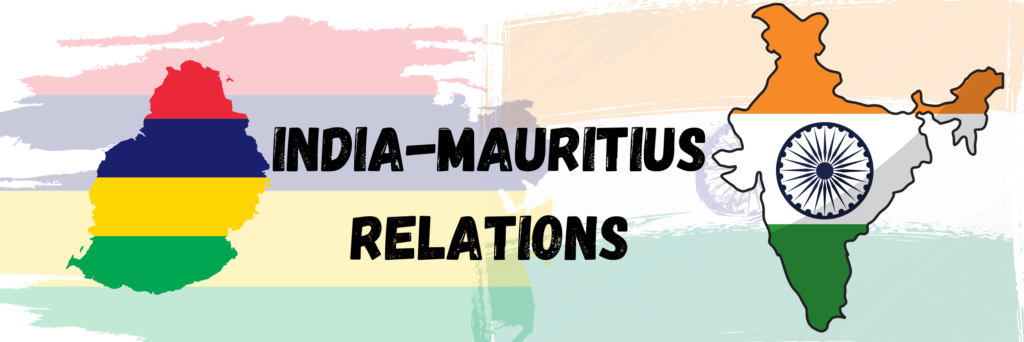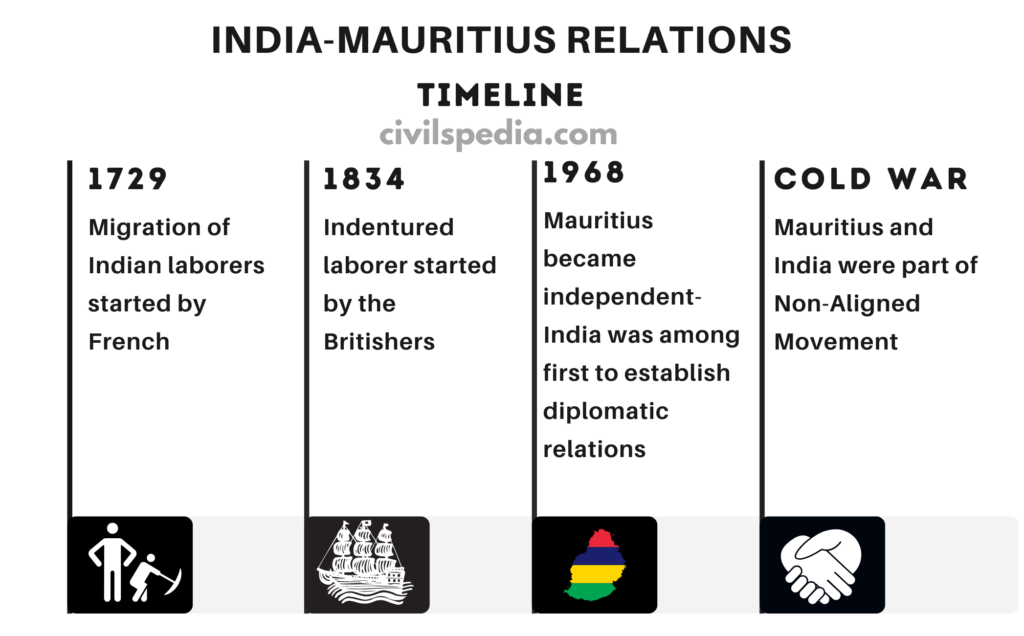Last Updated: September 2025 (India-Mauritius Relations)
Table of Contents
India-Mauritius Relations

This article deals with ‘India-Mauritius Relations.’ This is part of our series on ‘International Relations’, which is an important pillar of the GS-2 syllabus. For more articles, you can click here.
Introduction
India and Mauritius share a relationship that is often described as civilisational rather than transactional. Bound together by a common history of migration, culture, language and values, Mauritius hosts one of the largest Indian-origin communities in the world. These deep people-to-people ties have translated into close political, economic, and security cooperation, making India Mauritius’ principal development partner and security provider in the Indian Ocean region. The island nation, in turn, serves as a bridge for India’s outreach to Africa and a key node in its maritime strategy.
Historical Context

- Early Contacts: Indian migration to Mauritius began under French rule in 1729 and intensified under British rule (1834–early 1900s) with the arrival of over half a million Indian indentured labourers. This laid the foundation for today’s large Indian-origin population.
- Diplomatic Relations: India was among the first countries to establish diplomatic ties with independent Mauritius in 1968.
- Shared Anti-Colonial Outlook: Both countries were active in the Non-Aligned Movement (NAM) and supported each other in anti-colonial and decolonisation efforts.
Defence
- India is developing infrastructure, such as a runway and jetty in the Agalega Islands, to enhance surveillance and connectivity.
- Mauritius is a key part of India’s “Necklace of Diamonds” strategy, aimed at countering China’s String of Pearls strategy. It offers India both political leverage and a logistical point in the Western Indian Ocean.
- India has played a crucial role in developing the Mauritian Coast Guard, supplying patrol vessels, aircraft and training.
Economic Relations
- Bilateral Trade: Trade increased from USD 206.76 million (2005–06) to USD 851.13 million (2023–24).
- Indian exports: USD 778.03 million
- Mauritian exports: USD 73.10 million
- FDI Source: Mauritius remains a major source of FDI into India — about USD 175 billion since 2000 (roughly 25% of total inflows).
- CECPA (2021): The Comprehensive Economic Cooperation and Partnership Agreement between India and Mauritius gives
- Preferential access to 310 Indian export items
- Preferential access to 615 Mauritian products, including speciality sugar, juices, alcoholic beverages and medical devices.
- Local Currency Trade: Both countries have agreed to settle mutual trade in local currencies, reducing transaction costs.
- Digital Public Infrastructure: Mauritius has joined India’s Digital Public Infrastructure initiatives, with the launch of UPI and RuPay card systems to enhance digital payments and financial inclusion.
Diaspora
- Around 70% of Mauritius’ population is of Indian origin.
- Indian migration began under French rule in 1729 and expanded under British rule (1834–early 1900s), when over half a million Indian indentured labourers arrived.
- Two major political families of Indian descent — Jugnauths and Ramgoolams — have dominated Mauritian politics since independence in 1968.
Multilateral Forums
- Indian Ocean Rim Association (IORA): India and Mauritius work closely within IORA to promote regional maritime security, trade facilitation, and blue-economy cooperation.
- SAGAR Initiative: Mauritius is an important partner in India’s “Security and Growth for All in the Region” (SAGAR) vision for the Indian Ocean.
- Africa Outreach: Mauritius serves as a strategic hub for India’s outreach to the African continent through development, trade, and capacity-building programmes.
- Commonwealth Cooperation: Both countries coordinate positions within the Commonwealth of Nations on issues of democracy, development and small island states.
Other Cooperation
- India supports Mauritius’ claim over the Chagos Archipelago, which remains under UK control. The UK has leased Diego Garcia (largest island) to the USA for a military base.
- India is constructing the new Parliament building in Mauritius.
- In 2025, India announced a plan to train 500 Mauritian civil servants over five years under a tailored capacity-building initiative.
Issues
- Chinese Challenge: China’s growing footprint in the Indian Ocean (String of Pearls) raises security concerns for India and makes Mauritius strategically sensitive.
- Tax & Investment Concerns: Mauritius has traditionally been a major route for FDI into India. Changes to the India–Mauritius Double Taxation Avoidance Agreement (DTAA) and stricter rules on “treaty shopping” have reduced inflows and created friction between businesses.
- Delayed Project Implementation: Some Indian-assisted infrastructure projects in Mauritius have faced delays and cost escalations, creating local criticism.
- Competition from Other Investors: Japan, France and Gulf countries are also stepping up their engagement with Mauritius, leading to more competition for Indian projects.
